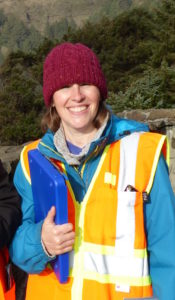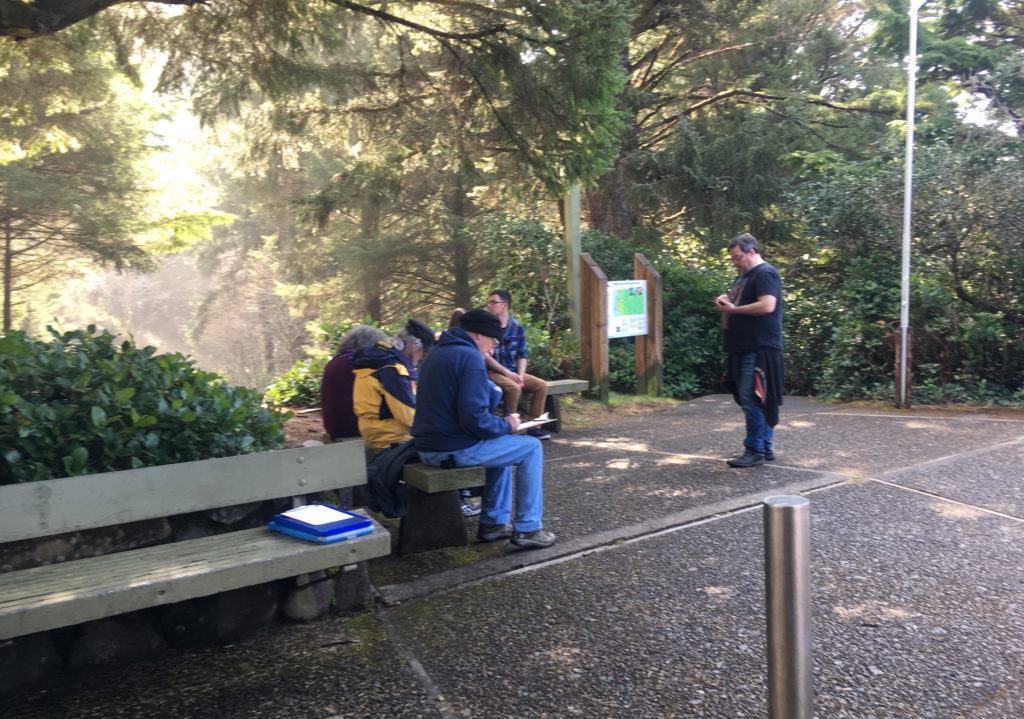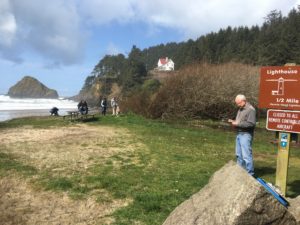
By DANA TIMS/YachatsNews.com
It’s hard to know what a post-coronavirus world will look like for Oregon’s central coast and how its businesses and individuals will go about piecing back together anything that looks like normal.
But for Yachats and surrounding communities it’s a good bet that proximity to Cape Perpetua and its state-protected marine reserve area will play a key role in any rebuilding effort.
That’s one of the key takeaways from a recently completed, first-of-its-kind survey of coastal visitors, who were interviewed at five specific points over the course of two years in a collaborative effort involving a number of governmental, tribal and non-profit organizations.
“No one has done anything this comprehensive before,” said Charlie Plybon, Oregon policy manager for Surfrider Foundation, an environmental activist organization that participated in the survey. “But the conclusions really shine a light on the economic rationale for protecting these special places.”

Between November 2017 and November 2019, a total of 919 surveys were completed by visitors, all of them personally contacted by Tara DuBois, communications manager for the Cape Perpetua Collaborative.
About three-quarters of all respondents stayed overnight on the coast during their trip for an average of four nights, according to the results. Respondents stayed overnight primarily in the towns of Yachats (29 percent), Florence (25 percent) and Newport (22 percent). Survey-takers also reported spending, on average, $88 on groceries, $423 on lodging, $134 on restaurants and $70 on fuel.
Yet, if the survey highlighted how lucrative tourism is to coastal economies, it also pointed out how important the Cape Perpetua Marine Reserve is, in particular, to Yachats and surrounding areas.
A prior survey, conducted in 2012 by the Oregon Department of Fish & Wildlife, for instance, showed that a scant 7 percent of respondents were aware of the reserve. That figure grew to 29 percent in a follow-up effort two years later. In the newly released survey, fully 37 percent of respondents reported knowing about the reserve.
“Ten years ago, Oregon’s marine reserves didn’t even exist,” Plybon said. “What the survey tells us is that our public outreach efforts are working and that people are now making the Cape Perpetua Marine Reserve one of their prime coastal destinations.”

Cape Perpetua a big draw
Plybon and Briana Goodwin, Surfrider’s Oregon field manager, said the survey results indicate that both in-state and out-of-state visitors are likely to head toward large, protected outdoor areas such as the Cape Perpetua reserves once current shelter-in-place orders begin to be eased.
“We are still likely to be observing social distancing etiquette, which are easily practiced in places like this,” Plybon said. “In that sense, Oregonians have embraced social distancing for decades. They love getting out where they can be both alone and out in nature.”
Area businesses are likely to find the survey useful since it’s yet another tool they can use to reach potential visitors, said Jesse Dolan, central coast coordinator for the Oregon Coast Visitors Association.
“The survey contains some really great information on why people are coming to this particular part of the coast,” he said. “I think you’ll find that a lot of business owners are paying very careful attention to this.”
Yachats Mayor John Moore agreed.
“Everyone around here knows that Cape Perpetua is just a gem,” he said. “But the survey dives in very deep and gives us a lot of useful numbers that underscore how popular it is with visitors.”
According to the survey, 55 percent of respondents visited Yachats during their trip to the coast and 87 percent were satisfied with what they found in the area. From those respondents that visited Yachats, 26 percent indicated increased food and beverage options would have improved their visit. Just under 10 percent of respondents indicated increases in lodging options, family friendly activities, recreational outfitters/guides, and recreational gear rentals would have improved their visit to Yachats. From those respondents that did not visit Yachats, 17 percent indicated increases in food and beverage options would convince them to visit Yachats.
DuBois, who personally contacted every survey participant – in addition to untold hundreds who declined to donate the eight to 10 minutes it took to complete the survey – called the experience “nothing short of awesome.”

Every week for two years, she drove to five sample sites in the area – the Cape Perpetua Visitor Center, Spouting Horn geological feature, Neptune State Scenic Viewpoint pull-off, Strawberry Hill Wayside and Heceta Head Lighthouse State Scenic Viewpoint.
She sampled at all sites one day per week, systematically rotating the sample day each week to ensure each day was equally sampled.
Some days, she remained in her car the entire time as howling winds and sideways rain left the area bereft of visitors. On nicer days, if no one was around to contact, she found a few minutes to do yoga stretches.
Once, at Spouting Horn, she sat with a woman who’d agreed to take the survey. Looking out at the ocean, she said, “I think that’s a whale.” The woman with her added, “It’s black and white.”
“It was an orca,” DuBois. “Actually, an orca pod. It was just a fantastic thing to see.”
She added, “There’s a lot of great information in this survey. I think a lot of people on the coast are going to find it extremely interesting and useful, particularly as we finally get a chance to move beyond this virus.”
— Dana Tims is an Oregon freelance writer who contributes regularly to YachatsNews.com. He can be reached at DanaTims24@gmail.com


